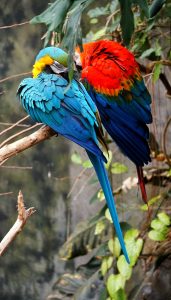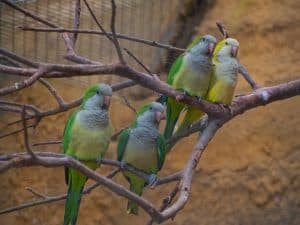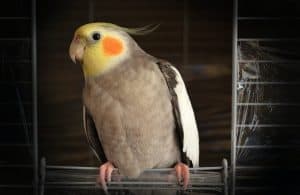As a bird owner, you may have heard the term “pin feathers” before. These small, often hard-to-see feathers are an important part of a bird’s feather structure and play a crucial role in feather regrowth. In this blog post, we’ll explore what pin feathers are, why they are important, how to identify them, and how to properly care for them.
What are Pin Feathers?

Pin feathers, also called blood feathers, are new feathers that are growing in to replace old feathers that are being shed. They are called “blood feathers” because they are still encased in a sheath with a blood supply flowing through them. The feather shaft, or quill, of a pin feather is not yet fully developed, and it may still be covered in a waxy coating. The central shaft of a pin feather is primarily composed of protein keratin and is surrounded by a blood supply, which provides nutrients for the feather growth.
Blood feather sheaths serve as protection against bacteria and parasites, as well as providing insulation. As the feather grows, it pushes out of its sheath and forms a fully-developed feather.
Types of Pin Feathers
There are two types of pin feathers: down feathers and contour feathers. Down feathers are the fluffy feathers closest to a bird’s body, while contour feathers are the larger feathers that give a bird its shape and color. Both types of feathers go through the same stages of growth and development.
Stages of Pin Feathers
Pin feathers go through three stages of growth: the emerging stage, the developing stage, and the hardening stage.
- Emerging Stage: During this stage, the pin feather emerges from the feather follicle and begins to unfurl. At this point, the feather shaft is still encased in a sheath.
- Developing Stage: In this stage, the feather continues to grow and the sheath begins to split open. The feather is still sensitive and fragile during this stage, so birds may be more sensitive and prone to injury.
- Hardening Stage: In the final stage, the feather shaft hardens and the sheath falls off. The feather is now fully developed and can withstand normal wear and tear.
Why are Pin Feathers Important?

Feathers are an essential part of a bird’s body, providing warmth, protection, and the ability to fly. Without proper feather growth and regrowth, a bird’s ability to fly and stay warm is compromised. Pin feathers play a critical role in feather regrowth, ensuring that birds have a constant supply of new feathers to replace old ones that have been shed.
Problems Associated with Pin Feathers
While pin feathers are important for birds, they can also cause problems. When a bird is growing new feathers, the pins can be sensitive and cause discomfort and irritation. This discomfort can lead to self-mutilation, feather plucking, and even feather damage. In extreme cases, a bird may bleed heavily if a pin feather is pulled or damaged.
Identifying Pin Feathers

Identifying pin feathers can be tricky, as they can be hard to see and may not be fully developed. However, there are a few things to look for to identify pin feathers:
- Appearance: Pin feathers are small and may look like short, stubby feathers. They may also be covered in a waxy coating.
- Location: Pin feathers are usually found on a bird’s head, neck, and body. They may also be found on the wings and tail.
- Color: Pin feathers may be pink or have a slightly different color than the surrounding feathers.
- Behavior: A bird with pin feathers may be more sensitive or irritable than usual, and may spend more time preening to help the pins unfurl.
How to Deal with Pin Feathers
- While pin feathers can cause problems for birds, there are steps you can take to minimize discomfort and ensure proper feather growth. Here are a few Avoid Handling: It’s important to avoid handling a bird’s pins or tugging on the feathers during the pin feather stage. This can cause pain, discomfort, and even bleeding.
- Provide a Proper Diet: Proper nutrition is essential for feather growth, so make sure your bird is getting a balanced diet that includes plenty of protein and other nutrients. Some birds may benefit from supplements or specific foods that promote feather growth.
- Encourage Preening: Birds naturally preen themselves to help the pins unfurl and the feathers grow properly. Encourage your bird to preen by providing a clean environment, toys, and perches that promote preening.
- Offer Bathing Opportunities: Bathing can help soften the sheath around the pin feather and make it easier to remove. Provide your bird with a shallow dish of water or a misting shower to encourage bathing.
- Seek Expert Advice: If you’re concerned about your bird’s pin feathers or notice any signs of discomfort or injury, seek advice from a veterinarian or avian expert. They can offer guidance on proper care and treatment.
Molting and Pin Feathers
Molting is a natural process in which old feathers are shed and new feathers grow to replace them. During molting, birds may have a large number of pin feathers as their bodies work to replace old feathers. Molting can be a stressful time for birds, so it’s important to provide extra care and attention during this period. Offering a healthy diet, plenty of bathing opportunities, and avoiding handling the pins can help make the molting process easier for your bird.
Pin Feathers – Final Thoughts
Pin feathers play a critical role in feather growth and regrowth for most of our pet birds. Understanding what pin feathers are, how to identify them, and how to properly care for them can help keep your bird healthy and comfortable. By providing a healthy diet, promoting preening, and seeking expert advice when needed, you can help your bird navigate the pin feather stage and ensure proper feather growth for years to come.
Other suggested articles:



